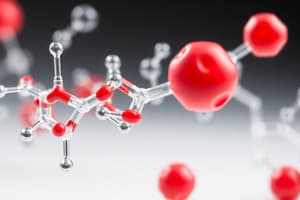Podcast
Questions and Answers
What effect does phosphorylation have on glycogen phosphorylase?
What effect does phosphorylation have on glycogen phosphorylase?
- Has no effect on its activity
- Inhibits its synthesis
- Increases its activity (correct)
- Decreases its activity
Which statement is true regarding the effect of elevated insulin levels?
Which statement is true regarding the effect of elevated insulin levels?
- It represses enzyme synthesis in all physiological conditions
- It induces the synthesis of enzymes for glucose metabolism (correct)
- It decreases the synthesis of enzymes for glucose metabolism
- It has no effect on enzyme synthesis
How long does it typically take for alterations in enzyme levels due to induction or repression of synthesis to occur?
How long does it typically take for alterations in enzyme levels due to induction or repression of synthesis to occur?
- Minutes
- Seconds
- Hours to days (correct)
- Weeks
What is the primary change observed in competitive inhibition?
What is the primary change observed in competitive inhibition?
How do noncompetitive inhibitors primarily affect enzyme kinetics?
How do noncompetitive inhibitors primarily affect enzyme kinetics?
Which enzyme's activity is decreased by the addition of phosphate?
Which enzyme's activity is decreased by the addition of phosphate?
What role do heavy metals generally play in enzyme function?
What role do heavy metals generally play in enzyme function?
What is the impact of covalent modification on enzyme activity compared to allosteric regulation?
What is the impact of covalent modification on enzyme activity compared to allosteric regulation?
What is the main difference between induction and repression of enzyme synthesis?
What is the main difference between induction and repression of enzyme synthesis?
What happens to the apparent Km in the presence of a competitive inhibitor?
What happens to the apparent Km in the presence of a competitive inhibitor?
Which of the following best characterizes non-competitive inhibition?
Which of the following best characterizes non-competitive inhibition?
How does non-competitive inhibition affect the Lineweaver-Burk plot?
How does non-competitive inhibition affect the Lineweaver-Burk plot?
Which of the following statements about non-competitive inhibitors is TRUE?
Which of the following statements about non-competitive inhibitors is TRUE?
Which scenario exemplifies non-competitive inhibition?
Which scenario exemplifies non-competitive inhibition?
Which of the following is NOT a characteristic of competitive inhibitors?
Which of the following is NOT a characteristic of competitive inhibitors?
In the context of competitive inhibition, what does a change in apparent Km indicate?
In the context of competitive inhibition, what does a change in apparent Km indicate?
How do non-competitive inhibitors influence enzyme kinetics?
How do non-competitive inhibitors influence enzyme kinetics?
What role does glucose-6-phosphate play in the regulation of hexokinase?
What role does glucose-6-phosphate play in the regulation of hexokinase?
What is the primary characteristic of competitive inhibition in enzyme reactions?
What is the primary characteristic of competitive inhibition in enzyme reactions?
How does a competitive inhibitor affect the Km value of an enzyme-catalyzed reaction?
How does a competitive inhibitor affect the Km value of an enzyme-catalyzed reaction?
In a Lineweaver-Burk plot, the lines for competitive inhibition intersect at which axis?
In a Lineweaver-Burk plot, the lines for competitive inhibition intersect at which axis?
What type of bond do reversible inhibitors typically use to bind with enzymes?
What type of bond do reversible inhibitors typically use to bind with enzymes?
Which of the following statements about irreversible inhibitors is true?
Which of the following statements about irreversible inhibitors is true?
What is the effect of increasing substrate concentration in the presence of a competitive inhibitor?
What is the effect of increasing substrate concentration in the presence of a competitive inhibitor?
Which of the following correctly describes the effect of a non-competitive inhibitor?
Which of the following correctly describes the effect of a non-competitive inhibitor?
Which type of inhibition is characterized by the formation of an enzyme-inhibitor complex that does not compete for the active site?
Which type of inhibition is characterized by the formation of an enzyme-inhibitor complex that does not compete for the active site?
What is the effect of a competitive inhibitor on the rate of formation of the enzyme-substrate complex?
What is the effect of a competitive inhibitor on the rate of formation of the enzyme-substrate complex?
What is a key indicator that a reaction is undergoing competitive inhibition when analyzing Lineweaver-Burk plots?
What is a key indicator that a reaction is undergoing competitive inhibition when analyzing Lineweaver-Burk plots?
What is the role of allosteric effectors in enzyme regulation?
What is the role of allosteric effectors in enzyme regulation?
What distinguishes a homotropic effector from a heterotropic effector?
What distinguishes a homotropic effector from a heterotropic effector?
Which of the following best describes negative effectors?
Which of the following best describes negative effectors?
How does feedback inhibition regulate enzyme activity?
How does feedback inhibition regulate enzyme activity?
What is the primary function of protein kinases in enzyme regulation?
What is the primary function of protein kinases in enzyme regulation?
What effect does phosphorylation generally have on enzymes?
What effect does phosphorylation generally have on enzymes?
What do phosphoprotein phosphatases do in enzyme regulation?
What do phosphoprotein phosphatases do in enzyme regulation?
Which statement about allosteric enzymes is true?
Which statement about allosteric enzymes is true?
What happens when the concentration of the end-product G increases in a metabolic pathway?
What happens when the concentration of the end-product G increases in a metabolic pathway?
Which of the following is a limiting factor in enzyme activity regulation through phosphorylation?
Which of the following is a limiting factor in enzyme activity regulation through phosphorylation?
Flashcards
Non-competitive Inhibition
Non-competitive Inhibition
A type of enzyme inhibition where the inhibitor binds to a site on the enzyme different from the active site, preventing substrate binding.
Effect of Non-competitive Inhibition on Km
Effect of Non-competitive Inhibition on Km
Non-competitive inhibitors do not affect the binding of the substrate to the enzyme, meaning the enzyme still has the same affinity for the substrate.
Effect of Non-competitive Inhibition on Vmax
Effect of Non-competitive Inhibition on Vmax
Non-competitive inhibitors reduce the maximum rate at which the enzyme can catalyze a reaction (Vmax).
Lineweaver-Burk Plot for Non-competitive Inhibition
Lineweaver-Burk Plot for Non-competitive Inhibition
Signup and view all the flashcards
Overcoming Non-competitive Inhibition
Overcoming Non-competitive Inhibition
Signup and view all the flashcards
Example: Heavy Metal Inhibition
Example: Heavy Metal Inhibition
Signup and view all the flashcards
Example: Allosteric Inhibition of Hexokinase
Example: Allosteric Inhibition of Hexokinase
Signup and view all the flashcards
What is an enzyme inhibitor?
What is an enzyme inhibitor?
Signup and view all the flashcards
Irreversible Inhibitors
Irreversible Inhibitors
Signup and view all the flashcards
Reversible Inhibitors
Reversible Inhibitors
Signup and view all the flashcards
Competitive Inhibition
Competitive Inhibition
Signup and view all the flashcards
Vmax
Vmax
Signup and view all the flashcards
Km
Km
Signup and view all the flashcards
Lineweaver-Burk Plot
Lineweaver-Burk Plot
Signup and view all the flashcards
How does increasing substrate concentration affect competitive inhibition?
How does increasing substrate concentration affect competitive inhibition?
Signup and view all the flashcards
How does a competitive inhibitor affect Km?
How does a competitive inhibitor affect Km?
Signup and view all the flashcards
Allosteric Effectors
Allosteric Effectors
Signup and view all the flashcards
Negative Effectors
Negative Effectors
Signup and view all the flashcards
Positive Effectors
Positive Effectors
Signup and view all the flashcards
Homotropic Effect
Homotropic Effect
Signup and view all the flashcards
Heterotropic Effect
Heterotropic Effect
Signup and view all the flashcards
Feedback Inhibition
Feedback Inhibition
Signup and view all the flashcards
Covalent Modification
Covalent Modification
Signup and view all the flashcards
Protein Kinases
Protein Kinases
Signup and view all the flashcards
Phosphoprotein Phosphatases
Phosphoprotein Phosphatases
Signup and view all the flashcards
Phosphorylation
Phosphorylation
Signup and view all the flashcards
Glycogen phosphorylase
Glycogen phosphorylase
Signup and view all the flashcards
Glycogen synthase
Glycogen synthase
Signup and view all the flashcards
Enzyme induction
Enzyme induction
Signup and view all the flashcards
Enzyme repression
Enzyme repression
Signup and view all the flashcards
Allosteric regulation
Allosteric regulation
Signup and view all the flashcards
Multi-subunit allosteric enzymes
Multi-subunit allosteric enzymes
Signup and view all the flashcards
Rate-limiting step
Rate-limiting step
Signup and view all the flashcards
Study Notes
Course Information
- Faculty: Medicine
- Academic Year: 2024-2025
- Year: 1
- Semester: 1
- Module: Human Body Function (HBF) 102
- Module Specific Topic: Enzymes II: Enzyme Inhibition & Regulation
Enzyme Inhibition
- Enzyme inhibition occurs when a substance reduces the speed of an enzyme-catalyzed reaction.
- Inhibitors can be irreversible (bind covalently) or reversible (bind non-covalently).
- Reversible inhibitors are further categorized as competitive and non-competitive.
Competitive Inhibition
- In competitive inhibition, the inhibitor competes with the substrate for the active site.
- The inhibitor binds reversibly to the active site that the substrate would normally occupy.
- Consequently, the substrate cannot bind.
- Increasing substrate concentration reverses this effect
- Competitive inhibition increases the apparent Km but does not change Vmax.
- In a Lineweaver-Burk plot, competitive inhibition shows a change in the x-intercept, but not the y-intercept.
Non-Competitive Inhibition
- In non-competitive inhibition, the inhibitor does not compete with the substrate for the active site.
- It binds to a different site on the enzyme.
- This binding changes the enzyme's shape, impacting its ability to bind the substrate.
- Non-competitive inhibition reduces Vmax but does not change Km.
- In a Lineweaver-Burk plot, non-competitive inhibition shows a change in the y-intercept, but not the x-intercept.
- Heavy metals are an example of non-competitive inhibitor
Allosteric Inhibition
- Allosteric enzymes are regulated by molecules called effectors (or modifiers).
- Modifiers bind non-covalently at a site other than the active site.
- This binding can alter the enzyme's affinity for its substrate or its maximal catalytic activity.
- Positive effectors increase enzyme activity, while negative effectors decrease it.
- Homotropic effectors are the substrate itself;
- Heterotropic effectors are different from the substrate. Examples are feedback inhibition.
Covalent Modification
- Many enzymes can be regulated by adding or removing phosphate groups from specific amino acid residues (serine, threonine, or tyrosine).
- Phosphorylation reactions are catalyzed by protein kinases.
- Dephosphorylation is catalyzed by phosphatases.
- Phosphorylation can increase or decrease an enzyme's activity.
Induction and Repression
- Enzymes may be regulated by the rates of their synthesis or degradation.
- Increased or decreased synthesis affects the total number of active enzyme sites.
- This process is slower than allosteric or covalent modification.
Interactive Question Examples
- Correct answer: Captopril inhibition can be relieved by increasing substrate concentration.
- Correct answer: Heavy metal enzyme inhibitors bind to different sites than the active site.
Studying That Suits You
Use AI to generate personalized quizzes and flashcards to suit your learning preferences.
Related Documents
Description
Explore the concept of enzyme inhibition in this quiz focusing on competitive and non-competitive inhibitors. Understand how these inhibitors affect enzyme-catalyzed reactions, including their impact on kinetic parameters like Km and Vmax. Test your knowledge on the mechanisms and implications of enzyme regulation.




